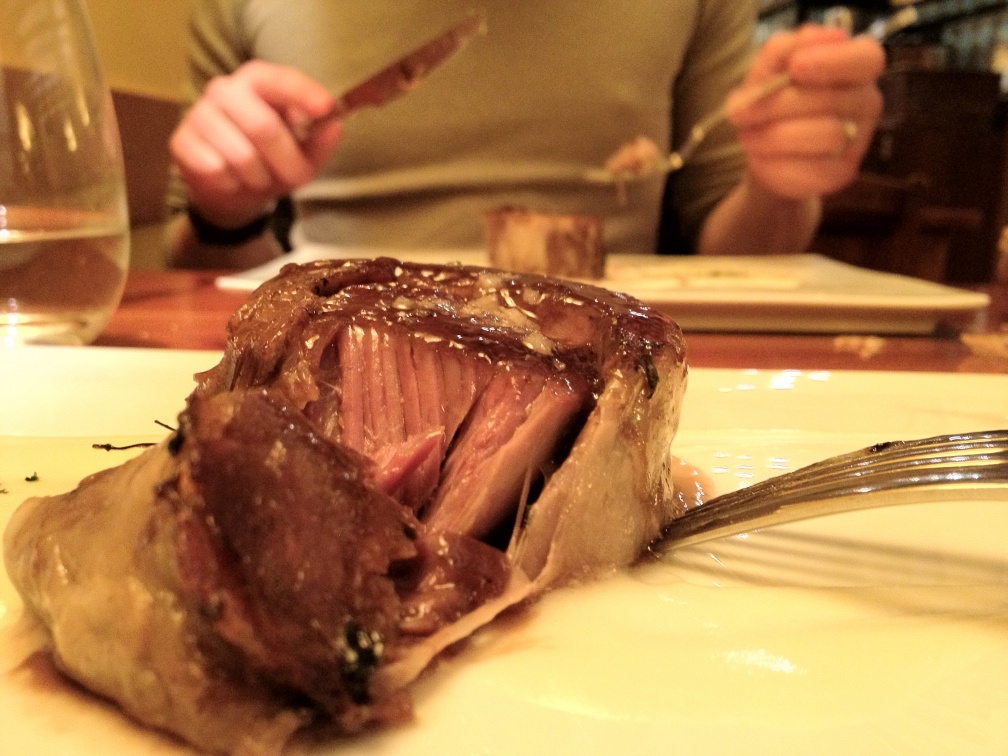Well, we’re a week into our Spanish tour and achieving new levels of awesomeness every day. I won’t try to give a blow-by-blow; for a pictorial description that’s more than you wanted to know, even before we’ve had time to add comments, check out the gallery.
Yesterday, we picked up our car, an adorable A-class Mercedes hatchback, and began our first foray into international road tripping. For the record, I had a beer and a coffee with lunch, and so started this experience with a double buzz. Leslie pointed out that this was probably for the best: a beer to relax me and a coffee to hone my attention.
I was mentally prepared for all kinds of hassles renting the car, but in fact it was considerably easier than in the states. Our credit card covered insurance, and they didn’t even try to upsell us on gas. The car is a diesel with a 6-speed manual transmission, but the clutch is very forgiving and it’s easy to drive. With only mild terror, we pulled into traffic and out of San Sebastian.
We were meant to stay in San Sebastian two nights. Our first night, we had a bit of a frustrating time trying to find good pintxos (pronounced something like “peenchos”), little snacks set out on plates at bars all over Basque country. There was no shortage of places serving this, but we learned quickly that if you could walk in and help yourself, they were bound to be old and probably not that impressive. Here’s an example of vast but not so good pintxos:

Leslie had researched several excellent pintxos bars, and you could spot them from down the street by the crowds boiling out onto the streets in front of their doors. Also by the fact that inside, there were no pintxos to be found, just hungry people waiting to pounce on the next plate to be brought out. Un pocito como asi:
If you know anything about Leslie and I, you can guess that this wasn’t exactly our scene. We retreated somewhat sheepishly to a nearby bar bar, like with drinks and stuff but no pintxos.
Another aside here, about drinking in Spain. Beer is expensive. Wine is cheap. It’s like bizarro land. A 0.4L glass of beer, which is considerably shy of a pint, will set you back 3-5 euros. And this beer is pretty crappy–some generic local pilsner, usually. The best mass-market one we’ve found so far is Keler, which was only served in Basque country. One night out of sheer luck we stumbled into the “Cat Bar” in the old town of Barcelona, which it turned out was run by a British ex-pat beer nerd (the tables were all covered in Brew Dog labels carefully removed from empties). Even he couldn’t provide good draft beer, but he pointed us to the one and only real beer bar in Barcelona, also in old town, which served a selection of German and American craft beers on tap! Haha! Also lots of bottles from Rogue, belgians, etc. So, I’m declaring that there’s no beer culture in spain. Fine, whatever. Our first day in San Sebastian, we got 3/4 bottle of totally drinkable Tempranillo for $6 and I officially gave up on beer 🙂
So anyway, we’ve retreated from the good pintxo bars on Friday night in San Sebastian, and stumbled on a bar serving two Keler beers for 3€. Holy shit, now we’re talking. We drank four while working on an increasingly difficult Sunday NYTimes crossword, then stumbled to what was the best fine-dining experience so far in Spain at Bodegón Alejandro, another one of Leslie’s finds.

The restaurants in San Sebastian work thusly: they open at 8:30 and close promptly at 10:30. So luckily we arrived by 8:45, and ended up as one of the last couples seated, and left well after 11. So it’s like there’s just one seating for every restaurant… weird and a seemingly lost opportunity since the streets of San Sebastian were thronging with people at 6:30pm, and I bet a lot were hungry. Spaniards just lack that capitalist killer instinct, I guess.

Unfortunately, after our excellent meal, we had to return to our pension with shared bath. We slept fine, woke up a bit hung over (and in Leslie’s case, with the beginning of a cold), and remembered that we didn’t have any towels, and they weren’t supplied in the bathroom, and so we had this sort of hilarious shower where we dried off using Leslie’s scarf, which worked even less well than it sounds. All our clothes were dirty. Our tasks for the day included finding and using a laundromat, renting our car, and then finding a place to park it overnight in bustling San Sebastian, which task you can understand the hilarious impossibility of by browsing our pictures of the town.
Fortified by a dose of cafe con leche, we floated the concept of getting the hell out of San Sebastian that day and sleeping somewhere else (there were a total of zero real hotel rooms available in San Sebastian). When we breezed through the car pick up and they said we were welcome leave it in the rental lot for a few hours, our spirits rose. While our laundry tumbled, we researched and booked a somewhat random hotel in the rural hills south of the coast, all on our fully internet connected US iPhones.
Ah, the phones! Time for another aside. Quite optimistically, we each brought our shiny new iPhone 4S with us, hoping that we’d be able to buy a local SIM card with data service and just pop them in. While stocking up on supplies for our stay in Barcelona, I hit up every major local carrier: Vodafone, Orange, Movistar, asking if I could buy a pre-paid SIM for the iPhone: these were some of my earliest substantive conversations in Spanish, and while halting the message was clear: no SIM for you! The iPhone 4(s) uses a microSIM, which is actually just a normal SIM with less plastic, and no one could provide one. I retreated to the hotel, and Googled a bit, and found a thread about a more pragmatic, multicarrier phone vendor called PhoneHouse. I went there, and for 20 euros a piece got prepaid SIMs that included high-speed internet access. But they weren’t micro! No problem, because they had a little device that just chopped them down to the right size. Amazingly, Sprint did not lock the SIM slot, and so we just popped them in and it worked. In fact, it’s much cheaper and better service than we have through Sprint in the US. And that is the story of how we were able to carry around our little internet-connected computers through our whole trip to spain.
So we’re in the laundry, and we book this hotel, and we tell the pension that thanks but no thanks we’re blowing town, and we pull out onto our first Spanish highway. And we’re in the mountains, and it’s beautiful. The drive proceeds like the beginning of a video game: You Can Drive In Spain. Level 1 is huge, wide highways. Level 2 is smaller local highways, Level 3 is Roundabouts: No Traffic Version. Level 4 is Now You’re Driving on Windy Mountain Roads and Level 6 is Now You’re On A Full Blown Dirt Road In The Mountains How the Fuck Can This Really Be The Way To The Hotel. But our Garmin GPS (a.k.a. the Marriage Saver) is not wrong, and after a quick inquiry with the friendly locals (who luckily speak Spanish in addition to Basque), we find the hotel. The hotel which is, in fact, a beautifully renovated 14th century blacksmithing building next door to a 14th century mansion. And we’re basically the only guests (in fact, we think we’re the only guests until halfway through dinner when one other couple comes out to eat). Highlights of the blacksmith include real, old-ass walls, amazingly friendly husband-and-wife staff, and a tiny puppy skittering around who quickly became Leslie’s best friend and confidant.